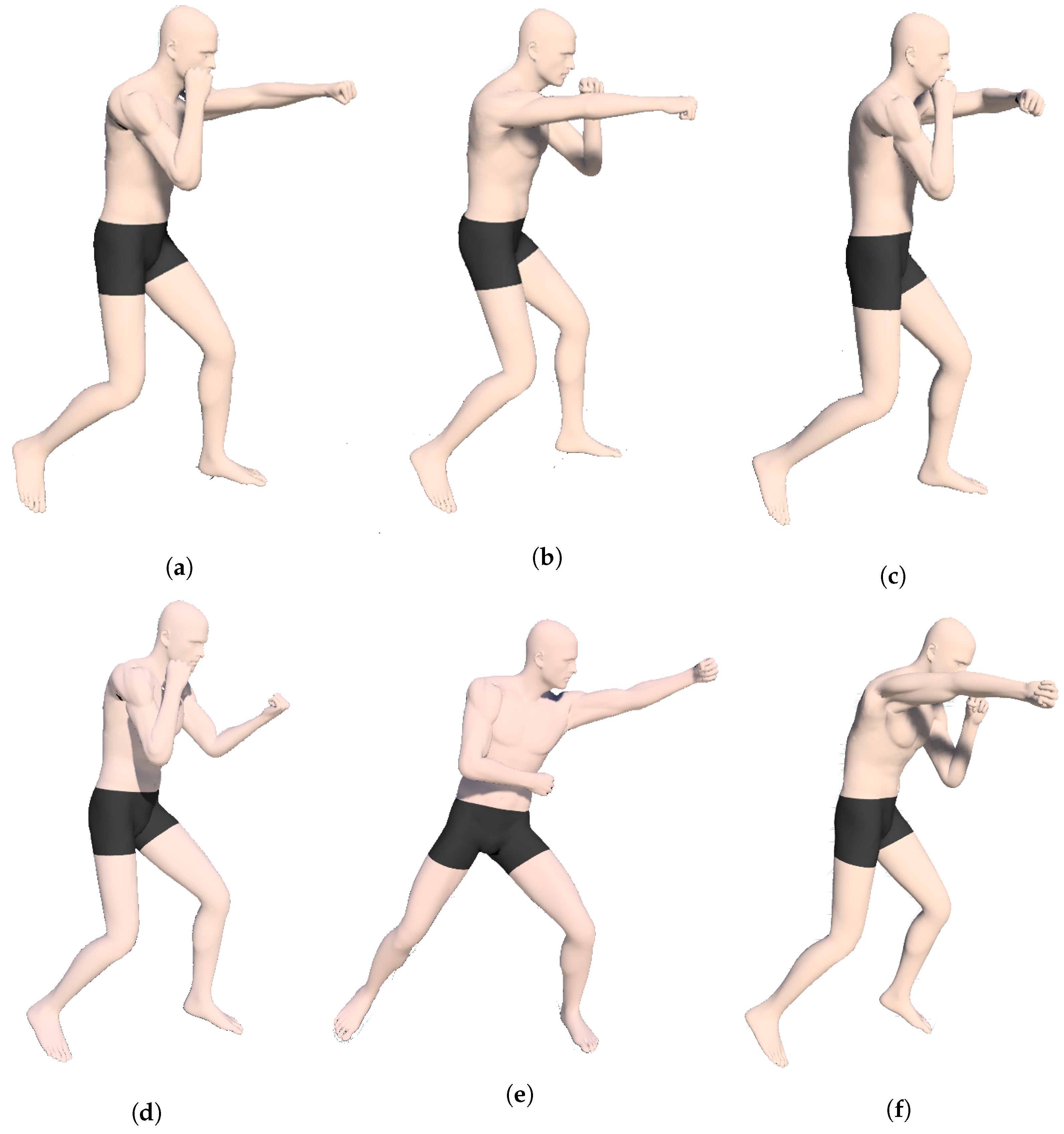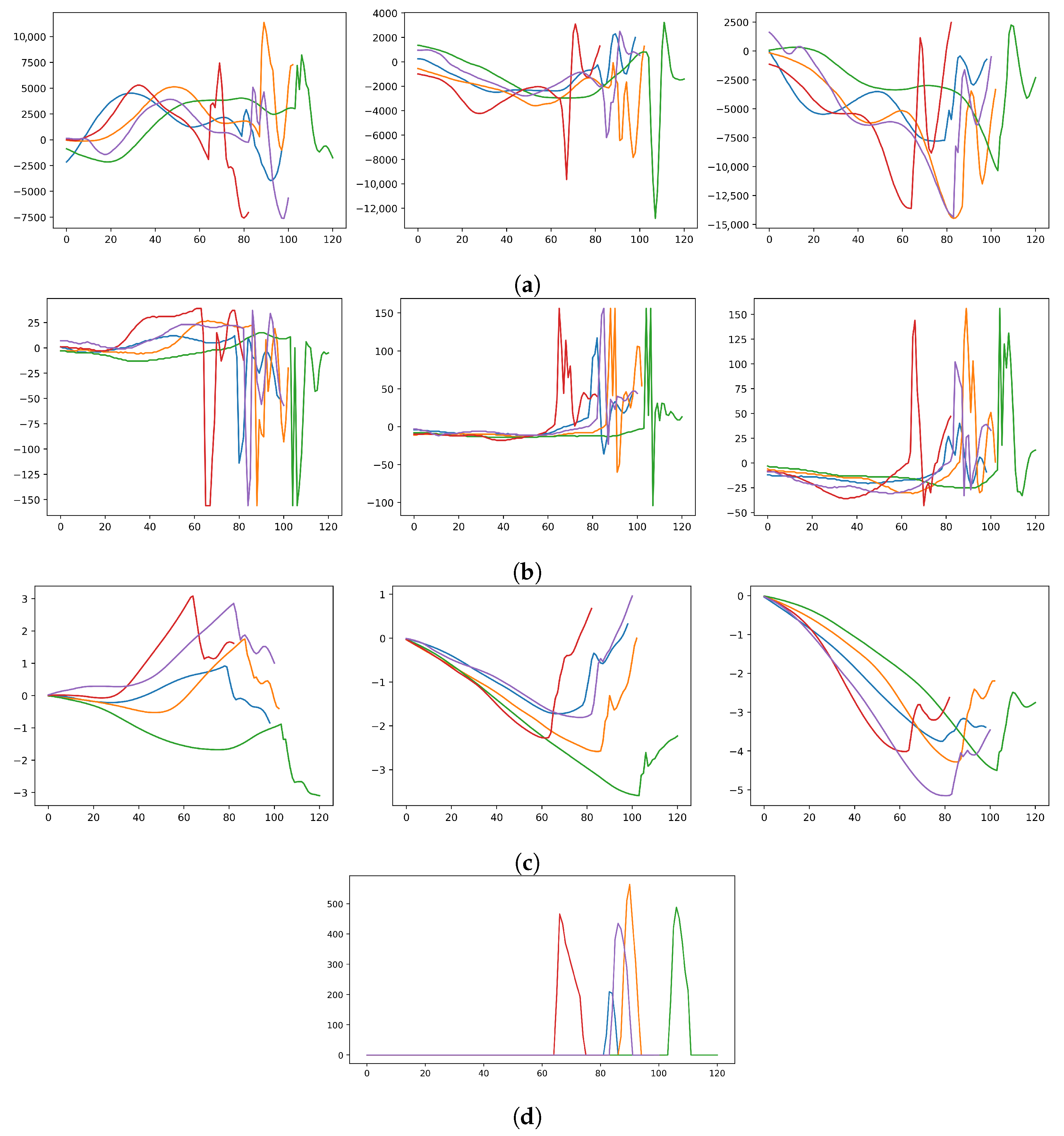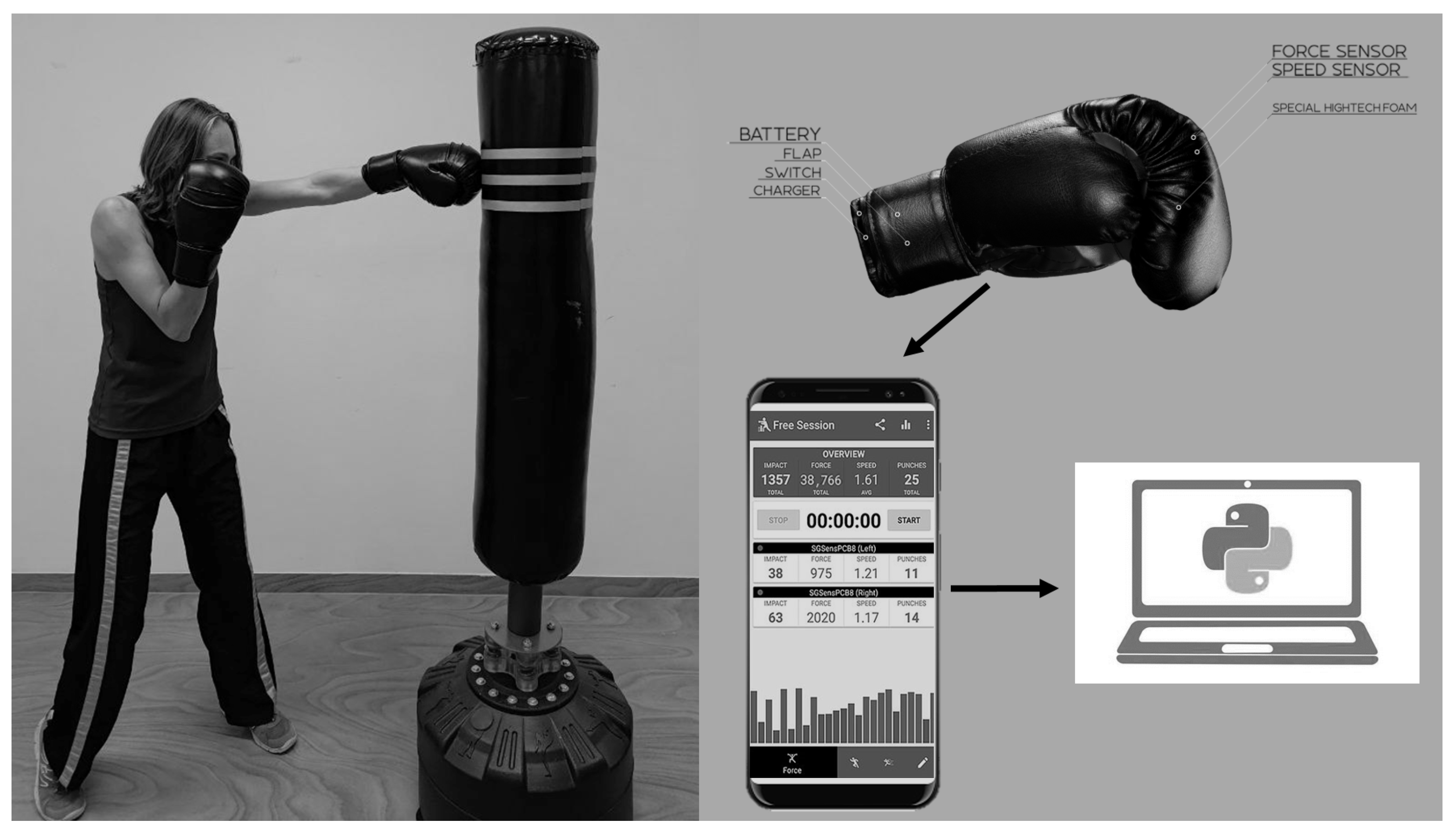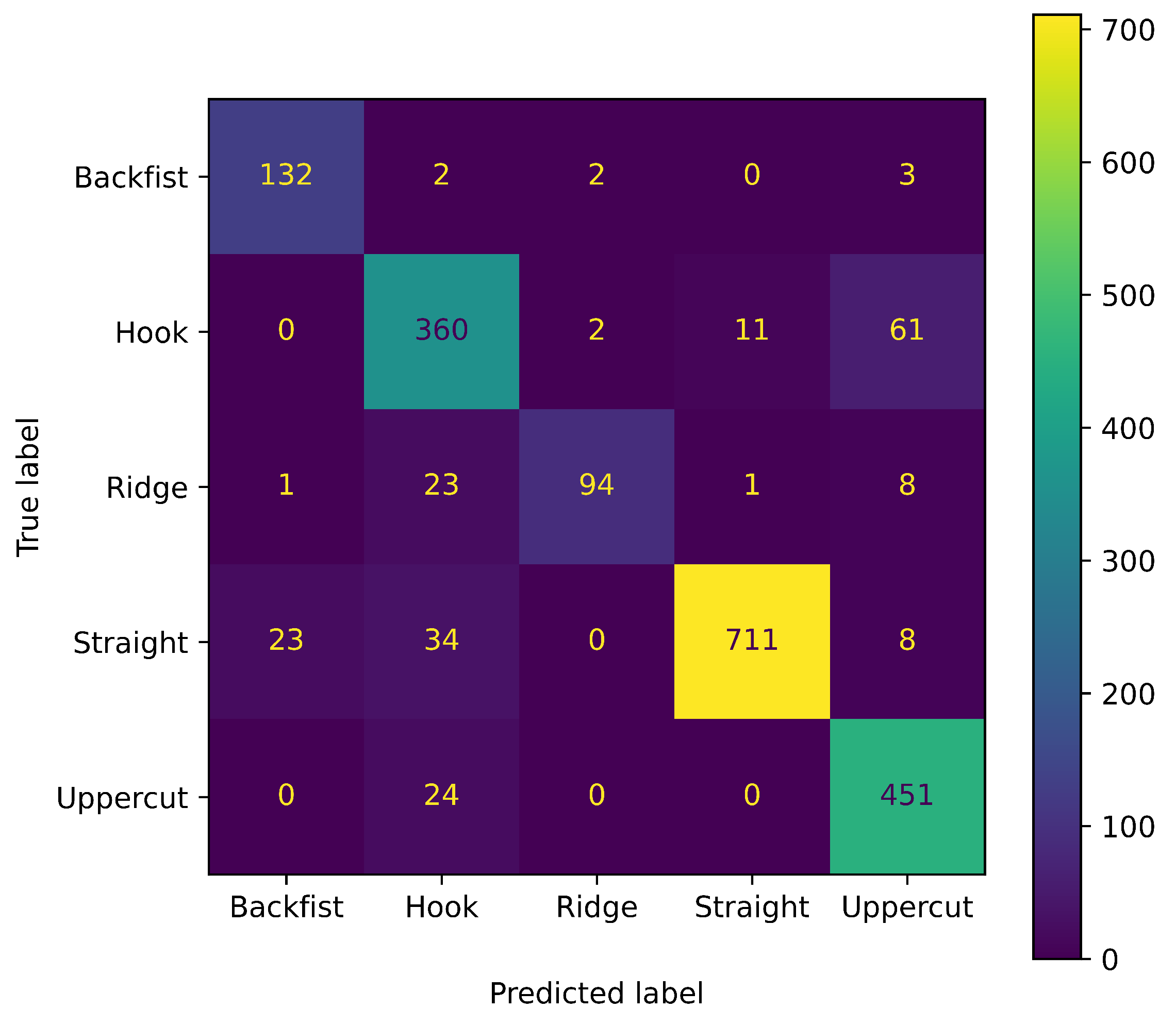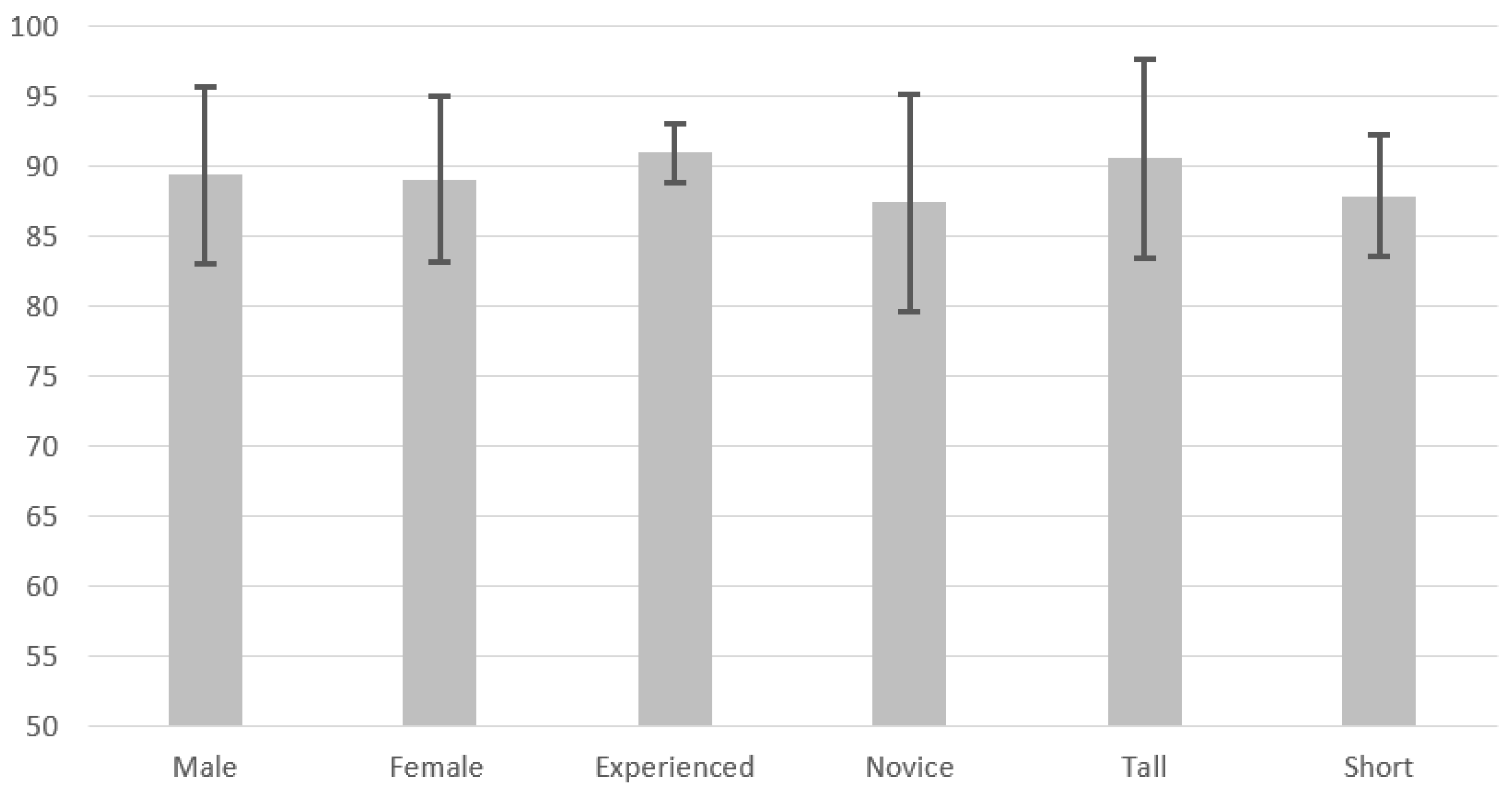Martial arts and combat sports, such as boxing, kickboxing, karate, and kung fu, seem to constantly increase in acceptance and popularity worldwide [
1], not solely in professional sports but even more in modern pop culture (e.g., movies, magazines, posters) and as a useful tool to gain physical fitness [
2], which is why they have become appealing to a broader variety of people. Although this trend, in general, can be viewed as a positive healthy development, it also involves certain challenges, in particular, injury risks [
3] or overtraining [
4]. This is because the majority of combat sports techniques, even in the absence of direct body contact, entail substantial impacts with the potential to cause harm to anatomical structures such as bones, joints, tendons, ligaments, and muscles, particularly when executed incorrectly or when performed under conditions of pronounced fatigue [
5,
6]. Nonetheless, mastering combat sports techniques demands a substantial dedication of time and guidance, typically spanning several years, potentially leading to considerable expenses [
7]. One assisting service to conquer these challenges can be provided by supporting technologies, such as the new prototype of a smart boxing glove, called “RISE Dynamics Alpha” (RD
) [
8,
9].
These smart boxing gloves are in an advanced prototypical state and consist of a novel validated [
10] force sensor (validation data not yet publicly available), as well as an inertial measurement unit (IMU) for measuring acceleration and angular velocity. Besides the RD
gloves, there exist other commercial products for data quantification. The products of FightCamp [
11], Hykso [
12], Rooq [
13], StrikeTec [
14], and Move It [
15] all consist of wearable IMU sensors combined with a software application that connects to sensors, collects data and displays different statistics, like punch speed and frequency or sometimes the techniques, of a workout session. However, these products solely measure the acceleration and angular change and calculate their derivatives. The RD
smart boxing gloves, on the other hand, allow the direct measurement of the punching force. With its corresponding mobile software application, it calculates further hit-specific data, such as impact, peak force, maximum speed, and maximum acceleration (both independent from direction) but also provides the full force, speed, and acceleration curve as “punch details” during every target contact.
Linking this information to a specific striking technique as well as to a specific target object should provide further analysis and quantification possibilities for athletes and instructors alike. For example, tailored exercises with corresponding, individualized body-strain plans, can be designed for technique improvement or injury prevention.
1.1. Automatic Human Body Movement Recognition
The recognition of human body movement and activity in various sport domains is an active research topic in the field of data science and machine learning. There have been several research projects where, based on movement data collected from sensors, machine-learning (ML) approaches have been applied to solve the recognition of human body movement. For example, Perri et al. [
16] focused in their study on the tennis-specific stroke and movement classification using machine learning based on data from a wearable sensor containing a tri-axial accelerometer, gyroscope, and magnetometer. Similarly, Kautz et al. [
17] evaluated the application of deep neural networks for the recognition of volleyball-specific movement data collected by a tri-axial wearable sensor. In addition, Cust et al. [
18] provides a systematic review of 52 studies on the topic of sport-specific movement recognition using machine and deep learning.
Among numerous other sporting disciplines, research projects have also been conducted in the realm of martial arts and combat sports, specifically examining and implementing machine-learning approaches. Therefore, the researchers aimed at solving certain classification tasks, like motion classification, with the goal to implement and deploy models that are capable of correctly recognizing e.g., a certain striking technique based on collected sensor data. These systems usually either make use of a wearable IMU sensor [
19,
20,
21], depth images [
22], or a 3D motion-capturing system based on video data combined with IMU sensors [
23]. In addition, Lapkova et al. [
24] used a stationary strain gauge sensor to measure the force and use the data as input for striking and kicking technique recognition.
As with the referenced projects, the RD gloves also incorporate an IMU sensor but additionally include a force measurement unit. Based on the biomechanical characteristics of a striking technique, the presumption was established that the data of the sensors can be used to train an ML model for the classification of striking techniques as well as target objects. This assumes that it is possible to identify patterns in the sensor data that are common among the samples for each striking technique, based on the physical characteristics like limb trajectory and acceleration.
1.2. Hand-Striking Techniques
For this research, only striking techniques that can be executed wearing boxing gloves were considered. This is due to the composition of the RD
system since the exact hand and finger positions cannot be identified like it is necessary for martial arts and combat sports such as kung fu [
25] or karate [
26] to differentiate between techniques. Thus, for the striking technique recognition, techniques from Boxing and Kickboxing were considered, which can be described as follows according to their rulebooks [
27,
28]:
Straight (Jab/Punch) [
29] (see
Figure 1a,b): Executed with the leading (Jab) or rear hand (Punch/Cross) in a straight line from the guard position towards the target object.
Hook [
29] (see
Figure 1c): Executed either with the lead or rear hand from the guard position by extending and then rotating the arm. In the end position, the upper and lower arm build approximately a 90-degree angle and are parallel to the ground.
Uppercut [
30] (see
Figure 1d): Executed either with the lead or rear hand from the guard position by slightly lowering down and rotating the hand and subsequently moving it upwards with the help of the upper body.
Backfist [
31] (see
Figure 1e): Most often used in pointfighting, which is a sub-discipline of kickboxing. The backfist is executed with the leading hand by extending the arm towards a target but with the intention to hit the target with the backside of the fist [
31].
Ridge hand [
31] (see
Figure 1f): The hand is rotated and moved in an arc trajectory with the intention to hit the target object with the back of the hand.
All striking techniques can generally be split into three phases, the segment acceleration, the target contact, and the restoring phase [
33]. For this paper, only the two former phases are relevant. The applied impact of a striking technique is the product of the effective mass of/behind the strike (
m), the (negative) acceleration (
a) during target contact, and the trajectory of the involved segments, during the target contact, see Equation (
1).
Naturally, the negative acceleration of the glove is highly affected by the target (e.g., a comparison between the concrete wall and a soft punching bag). Furthermore, for each striking technique, the trajectory of the boxing glove differs, also resulting in different force profiles. These characteristics render the velocity before the target contact, the trajectory (acceleration and relative angle in all three directions), as well as the impact and potential peak force as crucial factors to determine the technique and target.
Figure 2 shows the line chart of each feature over time of a jab. For comparison, five jab instances are plotted at once to depict the similarities between the curves. However, due to the positioning of the IMUs directly within the gloves, a solely rule-based differentiation between the techniques is not possible, as the rest-body movement is not known. This is why an ML-based approach might provide a solution to this problem.
1.3. Aims and Novelty
This study outlines the development process of an ML-based extension for the RD
system. The primary objective was to create an ML-based system capable of accurately recognizing striking techniques and identifying the target object using data obtained from sensors embedded in the smart boxing gloves. To achieve this, ML models were implemented for the classification of various striking techniques, described in
Section 1.2 and the differentiation between valid targets (e.g., punching bag, punch bag, gloves) and invalid targets (e.g., concrete wall) on which the striking techniques are executed.
To implement the classification models, it was necessary to identify the most suitable supervised machine-learning algorithms for the sensor data derived from the aforementioned sensors. Moreover, an assessment was carried out to determine which features and feature representations of the multi-variate time-series sensor data could be utilized for training and testing the supervised machine-learning models. Additionally, datasets were constructed for training and testing the implemented models, achieved through the conduction of two experiments involving mutually exclusive participant groups. Ultimately, the objective was to evaluate whether the developed classification approach, in conjunction with the data from the RD
system, could achieve a predictive accuracy of 85%. This value was chosen as a baseline since related work [
19,
20,
23,
24] showed the feasibility of achieving this accuracy rate. It was estimated that reaching this value would verify the proof of concept of the ML-based classification system and that the implementation of even higher accuracy can be achieved afterward through adaptations.
